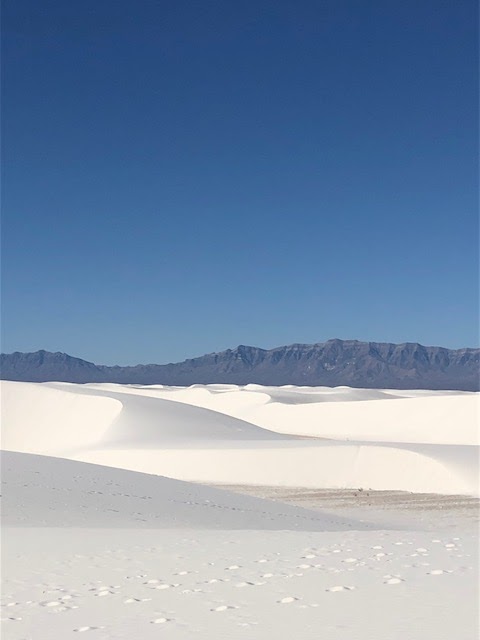I was going to sit down and study the maps. I was sort of hoping to find a couple of good maps that laid out all the data in one place. Well, I seem to have picked up enough of the geology, geography, history and social geography to at least nail down the basics so I can work on my plot.
Having the ground truth helps so much. I've seen the playa and the transition zones into the dune field and I've driven the distances between Alamogordo and Albuquerque.
The geology works. Basically, the playa is another face of the same chemistry that created the dunes. Well, that keeps creating them, as they are an ongoing and evolving feature. Water leaches gypsum from the surrounding mountains, which forms briny lakes. Those evaporate forming selenite crystals, which are broken up by weathering until they are fine enough to be carried by the wind, forming the dunes.
All of this White Sands geology (there's a lot more of it than gypsum sands!) is roughly contiguous with the ancient Lake Otero. There was a lush grasslands setting there around the Paleolithic. Mammoths and giant sloths and humans were living hunting et al along the lake edge and left tracks in the mud that, when conditions were right, were preserved.
So this is the right landscape. Outside the dunes but still within where the fine gypsum sand blows, where it is arid and alkali cool desert (elevation too; 1,000 feet or more). The water table is very close to the surface, as it happens (the sands proper go very deep; thirty feet at least).
Geographically it works for me. The playa are very close to the national monument but rather than the archeologists going down Dune Drive every morning, it makes more sense for them to get an escort from and through Holloman AFB. And it makes sense to have them at Alamogordo (Las Cruces would also be convenient, but while this is conveniently big city and a university town besides -- second largest town in New Mexico -- I like the vibe of Penny trying to deal with the small-town feel of Alamogordo.)
But in New Mexico space, Albuquerque or Roswell really aren't that far away. Psychically, the nuclear community has always transcended strictly physical mapping and the right people at Alamogordo can still feel like they are part and parcel with Los Alamos.
For ethno-history... I can make it work. It might even work better. There's the old pots-not-people problem but there's enough genetic data -- and the archaeological cultures are different enough -- that it does seem very likely that the pre-Clovis "Footprints" culture, the Archaic and paleoindian cultures like the Jornada Mogollon, and late-comers like the Apache, are really movements of people.
Put aside any thoughts of the "mysterious lost Anasazi," though. There's more than one reason why the modern name is "Ancestral Pueblo." Of course "Pueblo" is as much a blanket term as, say, Iroquois. Only in this case the facile name given by early Spanish explorers reveals something deep about the cultures of the Southwest. The same maize cultivation and arid landscape, the same adobe construction, and it is not entirely surprising similar rituals appear. And useful technologies spread. And the pueblo cultures are exogamous as well as traders in materials and ideas.
So while it matters that there are multiple language groups, and tribal distinctions within those language groups, it is also not incorrect to include Tewa Pueblo, Ancestral Pueblo, Hopi, and Dineh within some "pueblo" super-group. And, yes, some do claim continuity with the 1,500 - 1,000 BCE Jornada Mogollon (itself a super-culture designation).
Okay. Archaeological culture? A collection of distinctive artifacts frequently found in proximity and bounded by time and space. Pots not people. It just means that there's enough of this style of pottery and these particular ways of laying out a pit dwelling that can be identified as "kinda mostly like this through this stretch of territory over this period of time." It doesn't mean (though far too many take it to imply) that this is a "race" or some other distinctive identity cultural political and genetic.
And it works for me if "MacDonald" comes from family that lost their ranch when The Hill (Los Alamos) was eminent-domained out from under them, but came over the decades of living (and nuclear testing) in the White Sands area to identify strongly enough with that land he formed his own bonds with it. And if in his mind he associates his Tewa Pueblo with the Archaic cultures of the Southwest, or his own family with the Luchero family (yes, the source of the name Lake Luchero) who also lost their land to the government in 1940, that's his business.
And once again, it becomes Penny's business to fathom MacDonald's internal geography and find her way to the secret he was buried with.







No comments:
Post a Comment